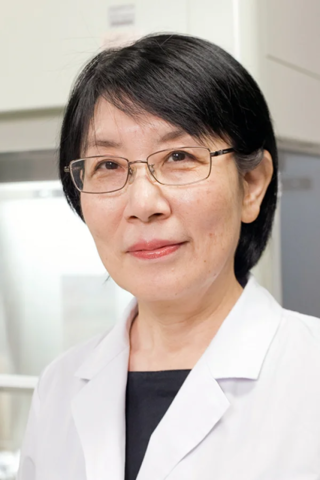Related Research Articles

A circadian rhythm, or circadian cycle, is a natural oscillation that repeats roughly every 24 hours. Circadian rhythms can refer to any process that originates within an organism and responds to the environment. Circadian rhythms are regulated by a circadian clock whose primary function is to rhythmically co-ordinate biological processes so they occur at the correct time to maximise the fitness of an individual. Circadian rhythms have been widely observed in animals, plants, fungi and cyanobacteria and there is evidence that they evolved independently in each of these kingdoms of life.

Chronobiology is a field of biology that examines timing processes, including periodic (cyclic) phenomena in living organisms, such as their adaptation to solar- and lunar-related rhythms. These cycles are known as biological rhythms. Chronobiology comes from the ancient Greek χρόνος, and biology, which pertains to the study, or science, of life. The related terms chronomics and chronome have been used in some cases to describe either the molecular mechanisms involved in chronobiological phenomena or the more quantitative aspects of chronobiology, particularly where comparison of cycles between organisms is required.
A zeitgeber is any external or environmental cue that entrains or synchronizes an organism's biological rhythms, usually naturally occurring and serving to entrain to the Earth's 24-hour light/dark and 12-month cycles.

A night owl, evening person or simply owl, is a person who tends or prefers to be active late at night and into the early morning, and to sleep and wake up later than is considered normal; night owls often work or engage in recreational activities late into the night, and sleep until relatively late in the day.
Circadian rhythm sleep disorders (CRSD), also known as circadian rhythm sleep-wake disorders (CRSWD), are a family of sleep disorders which affect the timing of sleep. CRSDs arise from a persistent pattern of sleep/wake disturbances that can be caused either by dysfunction in one's biological clock system, or by misalignment between one's endogenous oscillator and externally imposed cues. As a result of this mismatch, those affected by circadian rhythm sleep disorders have a tendency to fall asleep at unconventional time points in the day. These occurrences often lead to recurring instances of disturbed rest, where individuals affected by the disorder are unable to go to sleep and awaken at "normal" times for work, school, and other social obligations. Delayed sleep phase disorder, advanced sleep phase disorder, non-24-hour sleep–wake disorder and irregular sleep–wake rhythm disorder represents the four main types of CRSD.
In the study of chronobiology, entrainment occurs when rhythmic physiological or behavioral events match their period to that of an environmental oscillation. It is ultimately the interaction between circadian rhythms and the environment. A central example is the entrainment of circadian rhythms to the daily light–dark cycle, which ultimately is determined by the Earth's rotation. Exposure to certain environmental stimuli will cue a phase shift, and abrupt change in the timing of the rhythm. Entrainment helps organisms maintain an adaptive phase relationship with the environment as well as prevent drifting of a free running rhythm. This stable phase relationship achieved is thought to be the main function of entrainment.
A chronotype is the behavioral manifestation of underlying circadian rhythm's myriad of physical processes. A person's chronotype is the propensity for the individual to sleep at a particular time during a 24-hour period. Eveningness and morningness are the two extremes with most individuals having some flexibility in the timing of their sleep period. However, across development there are changes in the propensity of the sleep period with pre-pubescent children preferring an advanced sleep period, adolescents preferring a delayed sleep period and many elderly preferring an advanced sleep period.
Light effects on circadian rhythm are the effects that light has on circadian rhythm.

Jürgen Walther Ludwig Aschoff was a German physician, biologist and behavioral physiologist. Together with Erwin Bünning and Colin Pittendrigh, he is considered to be a co-founder of the field of chronobiology.

A lark, early bird, morning person, or an A-person, is a person who usually gets up early in the morning and goes to bed early in the evening. The term relates to the birds known as larks, which are known to sing before dawn. Human "larks" may sleep from around 10 p.m. to 6 a.m., and tend to feel most energetic just after they get up in the morning. They are thus well-suited for working the day shift.
Colin Stephenson Pittendrigh was a British-born biologist who spent most of his adult life in the United States. Pittendrigh is regarded as the "father of the biological clock," and founded the modern field of chronobiology alongside Jürgen Aschoff and Erwin Bünning. He is known for his careful descriptions of the properties of the circadian clock in Drosophila and other species, and providing the first formal models of how circadian rhythms entrain (synchronize) to local light-dark cycles.
Till Roenneberg is a professor of chronobiology at the Institute of Medical Psychology at Ludwig-Maximilian University (LMU) in Munich, Germany. Roenneberg, in collaboration with Martha Merrow, explores the impact of light on human circadian rhythms, focusing on aspects such as chronotypes and social jet lag in relation to health benefits.
The Munich Chronotype Questionnaire (MCTQ) was created in 1976 by Till Roenneberg and Martha Merrow at Ludwig-Maximilians University (LMU) Munich. The MCTQ samples sleep and circadian rhythm data from more than 25,000 participants.
Arnold Eskin was a professor of chronobiology at the University of Houston in Houston, Texas. He attended Vanderbilt University, where he received a degree in physics. He later attended University of Texas at Austin, where he received his Ph.D. in zoology in 1969. He is recognized in the term Eskinogram, and has been a leader in the discovery of mechanisms underlying entrainment of circadian clocks.
The Society for Research on Biological Rhythms (SRBR) is an international chronobiological research society with three key goals:
- to promote the advancement and dissemination of basic and applied research in all aspects of biological rhythms.
- to enhance the education and training of students and researchers in the field.
- to foster interdisciplinary communication and an international exchange of ideas.

William Joseph Schwartz is an American neurologist and scientist who serves as Professor and Associate Chair for Research and Education in the neurology department at the University of Texas Dell Medical School. His work on the neurobiology of circadian timekeeping has focused on the mammalian suprachiasmatic nucleus. Schwartz demonstrated that the suprachiasmatic nucleus is rhythmic in vivo using a 2-deoxyglucose radioactive marker for functional brain imaging. As of 2014, he is editor of the Journal of Biological Rhythms.
Achim Kramer is a German chronobiologist and biochemist. He is the current head of Chronobiology at Charité – Universitätsmedizin Berlin in Berlin, Germany.

Sato Honma is a Japanese chronobiologist who researches the biological mechanisms of circadian rhythms. She mainly collaborates with Ken-Ichi Honma on publications, and both of their primary research focuses are the human circadian clock under temporal isolation and the mammalian suprachiasmatic nucleus (SCN), its components, and associates. Honma is a retired professor at the Hokkaido University School of Medicine in Sapporo, Japan. She received her Ph.D. in physiology from Hokkaido University. She taught physiology at the School of Medicine and then at the Research and Education Center for Brain Science at Hokkaido University. She is currently the director at the Center for Sleep and Circadian Rhythm Disorders at Sapporo Hanazono Hospital and works as a somnologist.
The bunker experiment was a scientific experiment that began in 1966 to test whether humans, like other species, have an intrinsic circadian clock. It was started by Jürgen Aschoff and Rütger Wever of the Max Planck Institute for Behavioral Physiology and later taken over by Jürgen Zulley. Participants lived in a bunker for multiple weeks while scientists measured their daily rhythms in many variables. The main conclusion of the experiment was that humans have an intrinsic clock with a period greater than 24 hours. The experiment also established many features of this clock and paved the way for future circadian studies.
Ken-Ichi Honma is a Japanese chronobiologist who researches the biological mechanisms underlying circadian rhythms. After graduating from Hokkaido University School of Medicine, he practiced clinical psychiatry before beginning his research. His recent research efforts are centered around photic and non-photic entrainment, the structure of circadian clocks, and the ontogeny of circadian clocks. He often collaborates with his wife, Sato Honma, in work involving the mammalian suprachiasmatic nucleus (SCN), its components, and associated topics.
References
- ↑ Till Roenneberg, Anna Wirz-Justice & Martha Merrow (2003). "Life between clocks: daily temporal patterns of human chronotypes". Journal of Biological Rhythms . 18 (1): 80–90. doi:10.1177/0748730402239679. hdl: 11370/d4fcf07b-97b2-4d4a-b1fe-07596c20f5bf . PMID 12568247. S2CID 15655036.
- ↑ "Molecular Chronobiology - Merrow Lab - Institute of Medical Psychology - LMU Munich". www.imp.med.uni-muenchen.de. Retrieved 2017-04-13.
- ↑ "Sub-Project 4: Novel Clock Genes and Principles" . Retrieved 2017-04-27.
- ↑ "European Biological Rhythms Society board members" . Retrieved 2017-04-13.
- ↑ "XV EBRS Congress information" . Retrieved 2017-04-13.
- ↑ "Prof. Martha Merrow - AcademiaNet". www.academia-net.org. Retrieved 2017-04-13.
- ↑ "OnTime Consortium" . Retrieved 2017-04-13.
- ↑ "Warwick Medical School Summer UK Clock Club Programme" . Retrieved 2017-04-27.
- ↑ "European Biological Rhythms Society" . Retrieved 2017-04-13.
- ↑ "University of Groningen News" . Retrieved 2017-04-13.
- ↑ "NWO Research Projects Keeping time: molecular entrainment mechanisms of biological clocks" . Retrieved 2017-04-27.
- ↑ "University of Groningen: Substantial grant from Technology Foundation STW for chronobiologist Martha Merrow". 13 May 2011. Retrieved 2017-04-27.
- ↑ "LMU new appointments 2012" . Retrieved 2017-04-13.
- ↑ "LMU medical faculty" . Retrieved 2017-04-13.
- ↑ "Coursera: Instructor Martha Merrow" . Retrieved 2017-04-27.
- ↑ Search Results for author Merrow Martha on PubMed .
- ↑ "LMU Professor Martha Merrow" . Retrieved 2017-04-13.